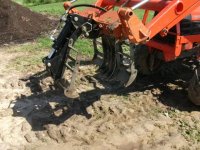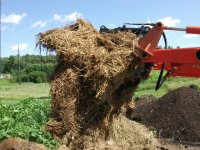You are using an out of date browser. It may not display this or other websites correctly.
You should upgrade or use an alternative browser.
You should upgrade or use an alternative browser.
Grapple cylinders
- Thread starter RJJR
- Start date
/ Grapple cylinders
#11
jake98
Veteran Member
- Joined
- Nov 10, 2007
- Messages
- 1,881
- Location
- Dingmans Ferry PA
- Tractor
- 53 Cub, 70's JD 410, Kioti 25hst
yeah, width ways. Here some pics.
That's the ticket! How much steel investment is there in something that size?
IslandTractor
Super Star Member
- Joined
- Sep 15, 2005
- Messages
- 17,101
- Location
- Prudence Island, RI
- Tractor
- 2007 Kioti DK40se HST, Woods BH
I'm looking for a light duty grapple. What are the advantages to a grapple with 2 hydraulic cylinders vs. just 1. Goint to be moving brush mostly.
Thanks
Everybody likes whatever type of grapple they own. I've never heard of anyone on TBN deciding to "move up" to a wider grapple or one with two upper jaws instead of one. I take that to mean that virtually everybody with a light duty single jaw grapple finds that they do the trick.
You can set up specific tasks where one or two grapple jaws would be better but for practical purposes either will work fine.
IMO the only reason many guys buy the wider two grapple jaw types is because some grapple salesman has never used a grapple on a CUT and is used to selling to skidsteer operators. Skidsteers are a different kettle of fish and use grapples differently than most CUT owners. Someday the sales people will wise up.
IslandTractor
Super Star Member
- Joined
- Sep 15, 2005
- Messages
- 17,101
- Location
- Prudence Island, RI
- Tractor
- 2007 Kioti DK40se HST, Woods BH
yeah, width ways. Here some pics.
Nice job. We discussed such a convertible grapple here about a year ago. Nice to see you have taken the initiative to put it into action. Looks like a very handy and capable grapple system.
deere5105
Veteran Member
One other thing I forgot about, involving the double clamp on a Bobcat, is that with the double the clamp portion is out flush with the edge of the bottom. I have often used this to reach up and grab limbs close to the tree and pull them down. This avoids having to use a chainsaw from an elevated position. It may work the same with a single. By getting the "grip" close to where the limb attaches to the tree, most times it pops right off.
kubotakid USA
Silver Member
Its pretty simple, you need two cylinders for the grapple buckets that have the two independant clamping jaws, 1 cyl, for each jaw, dont confuse this with the 2 cylinder 1 jaw setup, the 1 jaw grapples are limited in the materials they can safely and effectivley handle, a 2 jaw is far superior, Ill give you a good example, imagine having all 4 of your fingers glued together, thats like a 1 jaw grapple works, OR, allow them to work independitly, Thats how a two jaw grapple works,:thumbsup: unless your picking up a suite case, theres a HUGE difference, Eric
mjncad
Super Member
My preference is narrow. One vs. two cylinders has more to do with width. Get the one that fits your needs, there are countless variations out there. Weight has an effect as well, a #600 grapple can lift less than a #400 grapple on the same tractor. This is what I built, it weighs #100 and I have lifted 800-900 lb. rocks with it. I'm more then happy.
Nice job of design and fabrication!
SLHawkins
Gold Member
- Joined
- Nov 23, 2007
- Messages
- 435
- Location
- Northern Virginia
- Tractor
- John Deere 5403, International Harvester 584
Naw, mrkubotakid is right on the money. I have used both single and dual jaw grapples. 'Better' is a relative term. So, I will say it this way. Dual jaws are more effective at handling multiple objects of different size, or a an object that is not of uniform dimensions. The single jaw will work great with brush and the like. However, when you start dealing with solid objects (stumps, logs, rocks, etc), you will quickly discover its limitations. I used my single jaw for a couple of years doing lot clean-up. It does the job. However, after the first couple of clean up jobs, I said the next one will be independent dual jaws. It is hands down a more effective tool.
Hawk
Hawk
Redbug
Veteran Member
It seems the dual jaws would take more thinking to use. It would be a extra valve to operate and an extra valve/remote to install. I don't know...I'm from the one jaw camp...
SLHawkins
Gold Member
- Joined
- Nov 23, 2007
- Messages
- 435
- Location
- Northern Virginia
- Tractor
- John Deere 5403, International Harvester 584
It seems the dual jaws would take more thinking to use. It would be a extra valve to operate and an extra valve/remote to install. I don't know...I'm from the one jaw camp...
Extra valvle? Extra remote? How do you figure that? That is not a true statement. Both jaws operate off the same line and same switch/lever. No extra hoses, no extra valves, no extra lines. Other than the 3rd function valve required to open/close the grapple, there is not a 4th valve required to operate dual independent jaws vs a single jaw.
The will both open and close at the same rate until they hit a solid object. That is the beauty of the independent jaws. You can carry a 2-foot stump on one side and a 3-foot stump on the other. With a single jaw, once you close on the 3-foot stump that's it. Anything smaller is going to fall out.
But, if all you will be handling is brush, mulch, limbs, piles of hay and the like, then a single jaw grapple will suffice. When/if you start dealing with objects that are a little more solid and of various sizes, you quickly recognize the advantage of dual independent jaws.
Hawk


